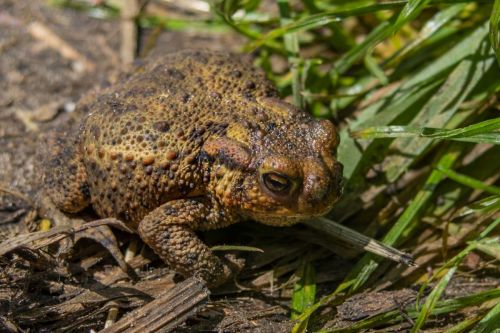An ugly pokey frog with a triangular head fixed lidless eyes, and a pair of tentacles on its mouth that draws attention by its unusual way of reproduction.
It has no teeth or tongue, with its nasal opening located at the end of its muzzle, but it is a great mother, which protects its offspring by storing them under special flaps on its back.
It is easy to breed and recommended even to beginner terrarium enthusiasts, but it is not among the cheapest frogs.
There are five genera and 33 species within the ridgeback family.
Its weight does not exceed 500 g. The muzzle is pointed, and the thorax is wide with a square outline. It has no tongue or teeth-it seeks food in the muddy bottom, turning over the silt with its front paws. Its external nasal openings are located at the end of its muzzle. Small eyes, widely spaced, and pointing upward, are placed on the edge of its head. It has a large mouth, ending in a pair of tentacles. Its limbs are thick and heavily muscled, ending in thin fingers with thread-like outgrowths (stellate organs) that facilitate spatial orientation and help sense invertebrates buried in the silt. The fingers are clasped with an amniotic membrane, allowing swimming.
The skin on its back is spongy and wrinkled with dark spots and tiny warts.
Females measure from 105 to 171 mm, while males measure from 106 to 154 mm.
They inhabit shallow, coastal parts of rivers, their tributaries with calm currents densely overgrown with vegetation, floodplains, and oxbow lakes. They can also be found in marshes or muddy drainage ditches. During the rainy season, they move between reservoirs without leaving the water when the area is flooded with rainwater. They can live in low-oxygen waters but are sensitive to chemical pollution.
It hunts primarily invertebrates, especially insects and their larvae, which it digs out of the silt with its thin fingers and rapidly places in its mouth.
During mating season, females emit a peculiar scent to attract males, and males emit a voice that resembles the ticking of a clock.
The complete development of the eggs and their transformation takes place in the skin on the female’s back. A single egg is 6-7 mm in diameter and each female lays from 40 to almost 500 eggs.
Individuals united in amplexus (a sexual reflex found in anuran amphibians) perform flips, each of which lasts several seconds. At a certain stage of this figure, the female lays eggs, which are immediately fertilized by the male and glued by him on the female’s back. Rich in blood vessels, the female’s skin forms special pockets around the glued eggs. After 10 days, the eggs are completely overgrown with skin - they develop in the closed pockets at a depth of 15 mm.
In the first few days of development, some of the eggs that have been shallowly buried in the female’s skin are also pushed out by eggs deeper in the skin.
After this time and complete resorption of the tail, the young leave the pockets in the mother’s skin. Initially, they swing their heads or limbs out for a drag of 1-2 seconds. After this time, they come to the surface of the water and begin to live independently. It seems likely that by making movements that tighten the muscles of the back, the female assists the young in getting out.
Soon the female undergoes moulting and her skin becomes smooth again and the remnants of the nesting pockets disappear.
The body dorsum of young specimens is uniformly gray and only after two weeks is there a concentration of dark pigment.
It has been observed that in adult Surinam toads the strongest food stimulus is the presence of some moving object touching their legs or head area, which the toad grasps with a vigorous mouth movement. However, no young specimens that stimulated the mother in this way were observed to be eaten by her.












